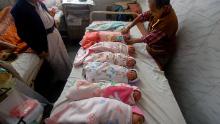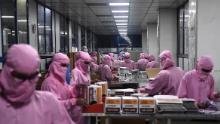How India plans to vaccinate 300 million people against Covid-19

But it is aiming to lift itself out of the crisis in the coming months with a massive vaccination drive — covering in its first phase almost as many people as the entire US population.
Indian Prime Minister Narendra Modi’s government has identified 300 million people to receive the first doses of the vaccines. The priority group is made up of 30 million health care workers, policemen, soldiers and volunteers, and 270 million vulnerable people — mostly citizens above the age of 50 and 10 million others with serious comorbidities.
The producers of three leading coronavirus vaccine candidates have applied for emergency use authorization, and all of them require two doses to provide sufficient immunity. That adds up to a total of 600 million shots, and Modi’s government wants to complete the whole process by August.
That’s an incredibly ambitious undertaking, especially for a developing country with poor rural infrastructure and an inadequate public health system that is already buckling under tremendous pressure from the coronavirus.
But India also has its own advantages. As a global hub for vaccine manufacturing, its mass production lines can churn out coronavirus vaccines — developed either by Western pharmaceutical companies or domestically — faster and cheaper than most other countries.
“Every single Indian who needs to be vaccinated will be vaccinated,” Indian Health Secretary Rajesh Bhushan said at a news conference on December 8.
Which coronavirus vaccines will be rolled out first?
Of the three Covid-19 vaccine candidates pending approval from Indian regulators, two are being manufactured locally in India.
One of them is Covishield, a vaccine developed by Oxford University and AstraZeneca and produced by the Serum Institute of India, the world’s largest vaccine maker.
The other is India’s first homegrown coronavirus vaccine, Covaxin, developed jointly by Bharat Biotech and the government-run Indian Council of Medical Research.
Pfizer India has also applied for emergency use authorization for the coronavirus vaccine developed by Pfizer and BioNTech, Dr VK Paul, head of the national expert group on Covid-19 vaccination, confirmed to CNN.
Adar Poonawalla, CEO of Serum Institute of India, said his company is currently producing 50 to 60 million doses of Covishield per month, and production will be scaled up to 100 million doses a month after January or February.
But Poonawalla has made it clear that his company will focus on immunizing India first before sending the vaccines overseas.
According to Serum Institute of India, Covishield could be sold to the Indian government for about $3 for two doses, and later $6 to $8 on the private market. That is likely much cheaper than the Pfizer-BioNTech vaccine, which is sold to the US government for $19.5 for a single does — although Pfizer India has not announced the price for India.
Covishield has another advantage — it only needs to be stored at standard refrigerator temperatures of 2 to 8 degrees Celsius (36 to 46 degrees Fahrenheit). Pfizer’s vaccine, on the other hand, requires an ultra-cold storage temperature of -75˚C (-103˚F) — infrastructure that India lacks, and must be used within five days once refrigerated at higher temperatures.
What preparations are underway in India?
“We do have the advantage of having run a very large universal immunization program across this country,” said professor K. Srinath Reddy, president of the Public Health Foundation of India. “To some extent our health system is fairly well geared up.”
But vaccinating 55 million people in a year is still a far cry from the target of 300 million in just eight months.
The country currently has 239,000 vaccinators under the Universal Immunization Program, but fewer than 65% of them will be deployed to administer coronavirus vaccines, to avoid too much disruption to the routine vaccinations, according to Bhushan, the health secretary.
He said the central government is in collaboration with states to arrange additional vaccinators, but did not reveal how many more staff will be added.
“To get adequate work force of people to administer the injections, monitor the side effects, and then ensure that people come back for the second injection as well — I think that is going to be the challenge that we have to meet,” Reddy said.
According to the government’s guidelines released Monday, 100 to 200 people will be vaccinated per session per day and monitored for half an hour after receiving the shots to examine any adverse effects, reported CNN affiliate News 18.
A digital platform, the Covid Vaccine Intelligence Network (Co-WIN) system, will be rolled out to track enlisted participants and the delivery of Covid-19 vaccines.
The government is also ramping up its stocks of cold chain storage equipment such as walk-in coolers and freezers, deep freezers and ice-lined refrigerators. At present, the country has more than 80,000 pieces of cold chain equipment at about 29,000 locations, which can store enough Covid-19 vaccines for the first 30 million frontline workers, Bhushan said.
“All necessary resources of vaccination have been delivered to the states,” he added.
Manufacturers are also racing against time to increase syringe supplies. Rajiv Nath, managing director of Hindustan Syringes and Medical Devices, said the company was producing 560 million pieces of syringe per annum as of June.
“Currently we are making around 700 million pieces per annum capacity and we plan to increase the production rate to a billion pieces per annum capacity by the second quarter of next year,” he said.
Drawing from the electoral machinery
India’s decades-long Universal Immunization Program has traditionally focused on children — and to a lesser extent women. Its coronavirus vaccine drive, however, will focus on adults, and faces challenges in terms of both the sheer number of shots and gathering people to receive them, Reddy said.
And that’s where India’s electoral machinery for mobilizing the country’s huge adult population can come in handy, he said.
“We do have a well-oiled machinery, which conducts this in phases in different parts of the country,” Reddy said “That is a very orderly process, which proceeds extremely smoothly, even in the remotest corners of the country. So in terms of adult mobilization, it is a fairly well tested process.”
“The same process of identification and lineup can easily be replicated here (for the vaccine drive). Of course, the administration of the vaccine itself will have to be done by people who are trained for that,” Reddy said.
And Reddy believes training new vaccinators won’t be a difficult task.
“It is only a question of training people to administer intramuscular injections with safety and monitor for side effects,” he said. “We can actually recruit people with a science background, preferably science graduates … who can be trained easily and brought into the process as vaccinators under supervision.”
Vaccinating 1.3 billion people?
As the world’s second most populous country, India’s strategy is to vaccinate “a critical mass of people and break that virus transmission,” so that it doesn’t have to vaccinate the entire population of 1.3 billion, according to Balram Bhargava, director general of the Indian Council of Medical Research.
Health Secretary Bhushan also said at a news conference last month that “the government has never spoken about vaccinating the entire country.”
Reddy, from the Public Health Foundation of India, said after the first phase of 300 million people are vaccinated, experts can better assess how much of a threat the virus remains and then decide on how many more people will need to be inoculated.
“This is an evolving epidemic. And our response will have to be adaptive even in terms of deciding how many and how soon we’ll be vaccinated.” Reddy said.
“It is possible that conditions may change, and by that time the virus may not be as much of a threat as it is at the moment … But over a period of time, I believe about 60% to 70% of the population would need to be immunized,” he said.
CNN’s Rhea Mogul, Swati Gupta and Manveena Suri contributed to this story.














